Zhe Zhang
Pitch-Conditioned Instrument Sound Synthesis From an Interactive Timbre Latent Space
Oct 05, 2025Abstract:This paper presents a novel approach to neural instrument sound synthesis using a two-stage semi-supervised learning framework capable of generating pitch-accurate, high-quality music samples from an expressive timbre latent space. Existing approaches that achieve sufficient quality for music production often rely on high-dimensional latent representations that are difficult to navigate and provide unintuitive user experiences. We address this limitation through a two-stage training paradigm: first, we train a pitch-timbre disentangled 2D representation of audio samples using a Variational Autoencoder; second, we use this representation as conditioning input for a Transformer-based generative model. The learned 2D latent space serves as an intuitive interface for navigating and exploring the sound landscape. We demonstrate that the proposed method effectively learns a disentangled timbre space, enabling expressive and controllable audio generation with reliable pitch conditioning. Experimental results show the model's ability to capture subtle variations in timbre while maintaining a high degree of pitch accuracy. The usability of our method is demonstrated in an interactive web application, highlighting its potential as a step towards future music production environments that are both intuitive and creatively empowering: https://pgesam.faresschulz.com
Wan-Animate: Unified Character Animation and Replacement with Holistic Replication
Sep 17, 2025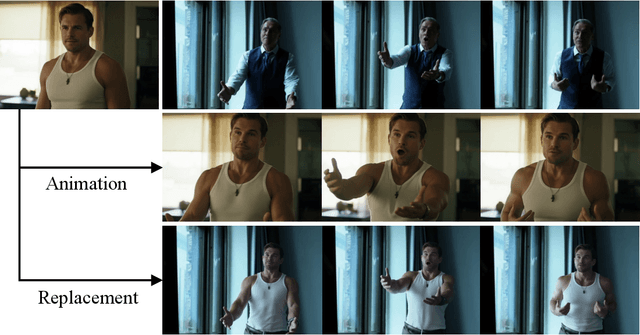


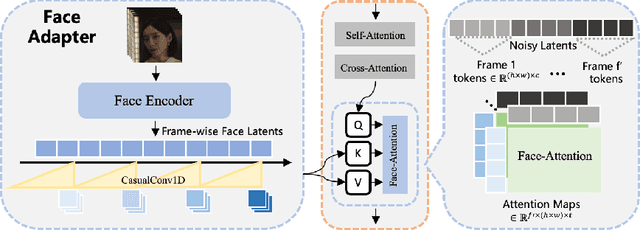
Abstract:We introduce Wan-Animate, a unified framework for character animation and replacement. Given a character image and a reference video, Wan-Animate can animate the character by precisely replicating the expressions and movements of the character in the video to generate high-fidelity character videos. Alternatively, it can integrate the animated character into the reference video to replace the original character, replicating the scene's lighting and color tone to achieve seamless environmental integration. Wan-Animate is built upon the Wan model. To adapt it for character animation tasks, we employ a modified input paradigm to differentiate between reference conditions and regions for generation. This design unifies multiple tasks into a common symbolic representation. We use spatially-aligned skeleton signals to replicate body motion and implicit facial features extracted from source images to reenact expressions, enabling the generation of character videos with high controllability and expressiveness. Furthermore, to enhance environmental integration during character replacement, we develop an auxiliary Relighting LoRA. This module preserves the character's appearance consistency while applying the appropriate environmental lighting and color tone. Experimental results demonstrate that Wan-Animate achieves state-of-the-art performance. We are committed to open-sourcing the model weights and its source code.
Robust Docking Maneuvers for Autonomous Trolley Collection: An Optimization-Based Visual Servoing Scheme
Sep 09, 2025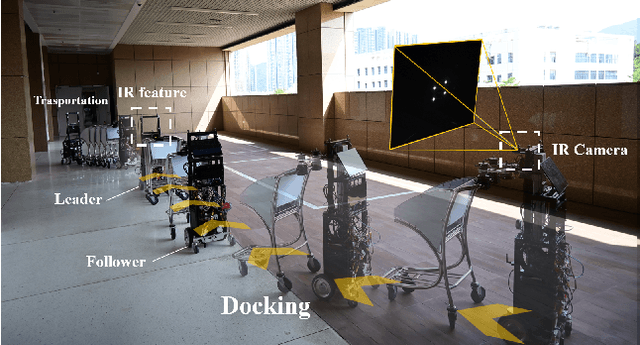

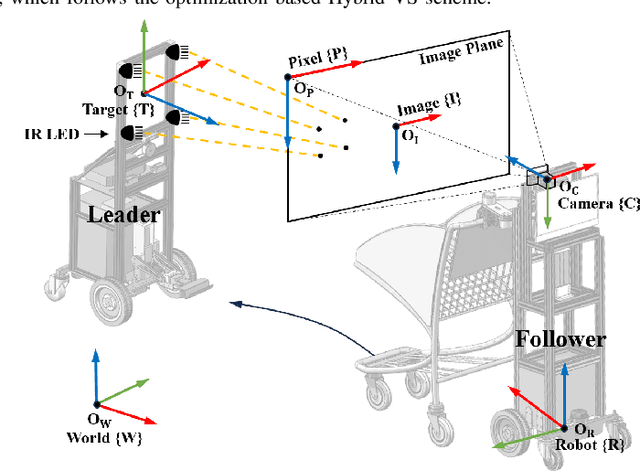

Abstract:Service robots have demonstrated significant potential for autonomous trolley collection and redistribution in public spaces like airports or warehouses to improve efficiency and reduce cost. Usually, a fully autonomous system for the collection and transportation of multiple trolleys is based on a Leader-Follower formation of mobile manipulators, where reliable docking maneuvers of the mobile base are essential to align trolleys into organized queues. However, developing a vision-based robotic docking system faces significant challenges: high precision requirements, environmental disturbances, and inherent robot constraints. To address these challenges, we propose an optimization-based Visual Servoing scheme that incorporates active infrared markers for robust feature extraction across diverse lighting conditions. This framework explicitly models nonholonomic kinematics and visibility constraints within the Hybrid Visual Servoing problem, augmented with an observer for disturbance rejection to ensure precise and stable docking. Experimental results across diverse environments demonstrate the robustness of this system, with quantitative evaluations confirming high docking accuracy.
${C}^{3}$-GS: Learning Context-aware, Cross-dimension, Cross-scale Feature for Generalizable Gaussian Splatting
Aug 28, 2025Abstract:Generalizable Gaussian Splatting aims to synthesize novel views for unseen scenes without per-scene optimization. In particular, recent advancements utilize feed-forward networks to predict per-pixel Gaussian parameters, enabling high-quality synthesis from sparse input views. However, existing approaches fall short in encoding discriminative, multi-view consistent features for Gaussian predictions, which struggle to construct accurate geometry with sparse views. To address this, we propose $\mathbf{C}^{3}$-GS, a framework that enhances feature learning by incorporating context-aware, cross-dimension, and cross-scale constraints. Our architecture integrates three lightweight modules into a unified rendering pipeline, improving feature fusion and enabling photorealistic synthesis without requiring additional supervision. Extensive experiments on benchmark datasets validate that $\mathbf{C}^{3}$-GS achieves state-of-the-art rendering quality and generalization ability. Code is available at: https://github.com/YuhsiHu/C3-GS.
ShortListing Model: A Streamlined SimplexDiffusion for Discrete Variable Generation
Aug 24, 2025Abstract:Generative modeling of discrete variables is challenging yet crucial for applications in natural language processing and biological sequence design. We introduce the Shortlisting Model (SLM), a novel simplex-based diffusion model inspired by progressive candidate pruning. SLM operates on simplex centroids, reducing generation complexity and enhancing scalability. Additionally, SLM incorporates a flexible implementation of classifier-free guidance, enhancing unconditional generation performance. Extensive experiments on DNA promoter and enhancer design, protein design, character-level and large-vocabulary language modeling demonstrate the competitive performance and strong potential of SLM. Our code can be found at https://github.com/GenSI-THUAIR/SLM
Dynamic Benchmark Construction for Evaluating Large Language Models on Real-World Codes
Aug 10, 2025Abstract:As large language models LLMs) become increasingly integrated into software development workflows, rigorously evaluating their performance on complex, real-world code generation tasks has become essential. However, existing benchmarks often suffer from data contamination and limited test rigor, constraining their ability to reveal model failures effectively. To address these, we present CODE2BENCH, a end-to-end pipeline for dynamically constructing robust and contamination-resistant benchmarks from real-world GitHub repositories. Specifically, CODE2BENCH introduces three key innovations: (1) Automated Dynamism, achieved through periodic ingestion of recent code to minimize training data contamination; (2) Scope Graph-based dependency analysis, which enables structured classification of functions into benchmark instances with controlled dependency levels (distinguishing between Self-Contained (SC) tasks for cross-language evaluation and Weakly Self-Contained (WSC) tasks involving permitted library usage); and (3) Property-Based Testing (PBT) for the automated synthesis of rigorous test suites to enable thorough functional verification. Using this pipeline, we construct CODE2BENCH-2505, the first benchmark derived from 880 recent Python projects spanning diverse domains, comprising 1,163 code generation tasks with 100% average branch coverage on ground-truth implementations. Extensive evaluation of 16 LLMs using CODE2BENCH-2505 reveals that models consistently struggle with SC tasks requiring complex, non-standard logic and cross-language transfer, while showing relatively stronger performance on WSC tasks in Python. Our work introduces a contamination-resistant, language-agnostic methodology for dynamic benchmark construction, offering a principled foundation for the comprehensive and realistic evaluation of LLMs on real-world software development tasks.
NTIRE 2025 Challenge on HR Depth from Images of Specular and Transparent Surfaces
Jun 06, 2025Abstract:This paper reports on the NTIRE 2025 challenge on HR Depth From images of Specular and Transparent surfaces, held in conjunction with the New Trends in Image Restoration and Enhancement (NTIRE) workshop at CVPR 2025. This challenge aims to advance the research on depth estimation, specifically to address two of the main open issues in the field: high-resolution and non-Lambertian surfaces. The challenge proposes two tracks on stereo and single-image depth estimation, attracting about 177 registered participants. In the final testing stage, 4 and 4 participating teams submitted their models and fact sheets for the two tracks.
Piloting Structure-Based Drug Design via Modality-Specific Optimal Schedule
May 12, 2025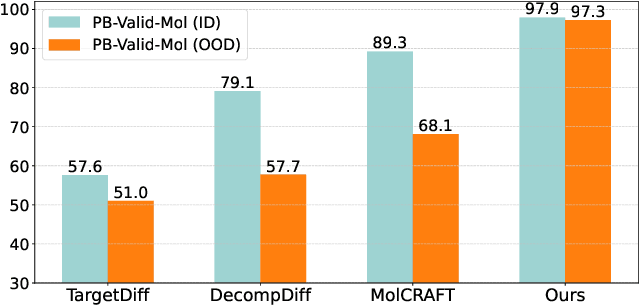
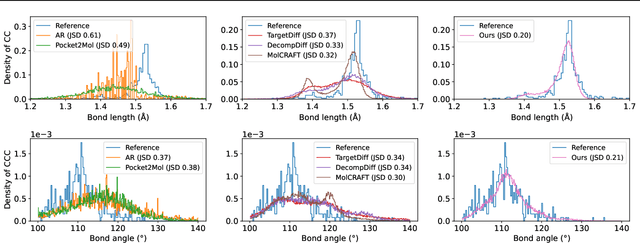
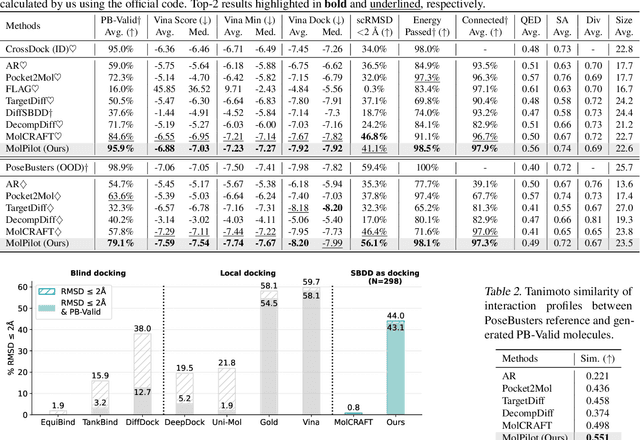

Abstract:Structure-Based Drug Design (SBDD) is crucial for identifying bioactive molecules. Recent deep generative models are faced with challenges in geometric structure modeling. A major bottleneck lies in the twisted probability path of multi-modalities -- continuous 3D positions and discrete 2D topologies -- which jointly determine molecular geometries. By establishing the fact that noise schedules decide the Variational Lower Bound (VLB) for the twisted probability path, we propose VLB-Optimal Scheduling (VOS) strategy in this under-explored area, which optimizes VLB as a path integral for SBDD. Our model effectively enhances molecular geometries and interaction modeling, achieving state-of-the-art PoseBusters passing rate of 95.9% on CrossDock, more than 10% improvement upon strong baselines, while maintaining high affinities and robust intramolecular validity evaluated on held-out test set.
CostFilter-AD: Enhancing Anomaly Detection through Matching Cost Filtering
May 02, 2025



Abstract:Unsupervised anomaly detection (UAD) seeks to localize the anomaly mask of an input image with respect to normal samples. Either by reconstructing normal counterparts (reconstruction-based) or by learning an image feature embedding space (embedding-based), existing approaches fundamentally rely on image-level or feature-level matching to derive anomaly scores. Often, such a matching process is inaccurate yet overlooked, leading to sub-optimal detection. To address this issue, we introduce the concept of cost filtering, borrowed from classical matching tasks, such as depth and flow estimation, into the UAD problem. We call this approach {\em CostFilter-AD}. Specifically, we first construct a matching cost volume between the input and normal samples, comprising two spatial dimensions and one matching dimension that encodes potential matches. To refine this, we propose a cost volume filtering network, guided by the input observation as an attention query across multiple feature layers, which effectively suppresses matching noise while preserving edge structures and capturing subtle anomalies. Designed as a generic post-processing plug-in, CostFilter-AD can be integrated with either reconstruction-based or embedding-based methods. Extensive experiments on MVTec-AD and VisA benchmarks validate the generic benefits of CostFilter-AD for both single- and multi-class UAD tasks. Code and models will be released at https://github.com/ZHE-SAPI/CostFilter-AD.
DiffOG: Differentiable Policy Trajectory Optimization with Generalizability
Apr 18, 2025Abstract:Imitation learning-based visuomotor policies excel at manipulation tasks but often produce suboptimal action trajectories compared to model-based methods. Directly mapping camera data to actions via neural networks can result in jerky motions and difficulties in meeting critical constraints, compromising safety and robustness in real-world deployment. For tasks that require high robustness or strict adherence to constraints, ensuring trajectory quality is crucial. However, the lack of interpretability in neural networks makes it challenging to generate constraint-compliant actions in a controlled manner. This paper introduces differentiable policy trajectory optimization with generalizability (DiffOG), a learning-based trajectory optimization framework designed to enhance visuomotor policies. By leveraging the proposed differentiable formulation of trajectory optimization with transformer, DiffOG seamlessly integrates policies with a generalizable optimization layer. Visuomotor policies enhanced by DiffOG generate smoother, constraint-compliant action trajectories in a more interpretable way. DiffOG exhibits strong generalization capabilities and high flexibility. We evaluated DiffOG across 11 simulated tasks and 2 real-world tasks. The results demonstrate that DiffOG significantly enhances the trajectory quality of visuomotor policies while having minimal impact on policy performance, outperforming trajectory processing baselines such as greedy constraint clipping and penalty-based trajectory optimization. Furthermore, DiffOG achieves superior performance compared to existing constrained visuomotor policy.
 Add to Chrome
Add to Chrome Add to Firefox
Add to Firefox Add to Edge
Add to Edge